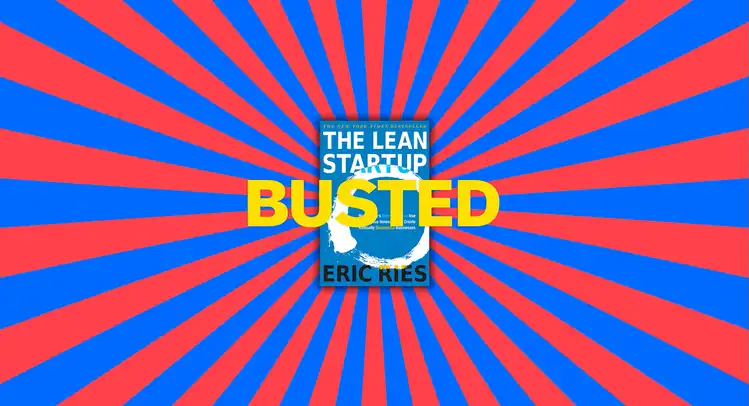Insights
Busting the Myth of The Lean Startup

Aware of the power of digital transformations, tech savvy execs are looking to increase the rate of change and adoption of emerging technology within their company. Since they are worried about disruptions to their business model, they are initiating all kinds of change accelerators such as innovation labs, corporate ventures, intrapreneur programs, corporate incubators, and internal startups. We have also witnessed a trend amongst these executives: they are utilizing author Erik Ries’ Lean Startup methodology as a guidebook for these programs. However, there are a few common misconceptions amongst Lean Startup followers that we often encounter.
Ries’ book popularized the notion of the startup as an experiment—a vehicle to learn how to build a sustainable business. Ries proposes that rather than focusing on results, startups should focus on learning about what the market is willing to pay for the services or products offered. This is where the popular MVP notion comes from, the mythic Minimal Viable Product. The MVP is the one thing that kickstarts your learning cycle: build, measure, learn, and repeat.
However, we’ve noticed that innovators often put a lot of effort in the product aspect of the MVP. Because Ries is using the word ‘product,’ many innovators consider the MVP to be the first releasable version of their product. Somehow this common misunderstanding has spread amongst teams, and too often their discussions are centred around which features should be included at launch, whereas the entire premise of the Lean Startup approach is to create a climate for fact finding and validating assumptions.
Successful innovation and product creation comes out of knowledge gathering: debunking common beliefs, assumptions and hearsay, and shifting a firm’s inward focus to a more customer-centric perspective. Instead of overthinking features or endlessly discussing products to-be, we aim for a more down-to-earth, Mythbuster-esque mindset. Let’s challenge your innovation approach and avoid common pitfalls with these five simple questions:
1. Are you sure you’re solving the right problem?
Instead of examining what their customers need, companies tend to listen to people who claim to know what their customers want. Or even worse, they ask customers directly what features they would like to see. Successful innovation starts with understanding customer issues and needs, based on validated insights, not opinions. These insights can then be used to solve problems your user may not be aware of—often with a much larger business potential.
2. Is your innovation process properly organized?
In software development and other innovation projects, agile methodologies like scrum almost have become standard practice. Agile and scrum are great methods for reducing the cost of change, but they are not the only way you can organize change. There is no silver bullet in project management methodology. If you’ve already discovered the problem you need to solve, Lean will help you focus on learning and reducing waste. And if you can leverage the power of commodity technologies, there is a lot to be gained by employing Six Sigma methodologies to reduce deviations. Bottom line: don’t be dogmatic about agile and choose the method that fits the challenge.
3. Do you have sufficient T-shapers on your team?
Most innovation requires a multitude of skills. We strongly believe in working with multi-disciplinary teams: multiple business owners, designers, developers, data-specialists working closely together. In many corporates, organisational or cultural silos prevent effective communication. And experts from different fields often aren’t trained to speak the same language. If you build a team, aim to find T-shaped specialists who enjoy bridging knowledge gaps and cultural differences. Finding a common language takes time, but it is always worth the investment.
4. Are you underestimating complexity, risk and output quality?
The Lean Startup method makes product development look easy, but don’t let it fool you—be prepared to deal with complexities. Maintaining good output quality requires clear output standards, and ensuring that the product is rigorously tested against them. In agile terms, work on the Definition of Done. Acknowledge that you can’t predict the future, know that the plans you have made aren’t set in stone and will probably have to change many times. And know that when you embrace change, many unexpected things will come your way.
5. Do you have what it takes?
Larger organizations tend to overestimate what they are capable of. Be realistic about the skills you need and fight for the right resources. Working with the best talent really does pay off—hire competent people and partners, be careful about outsourcing and offshoring, and keep teams autonomous and motivated to keep productivity at a high-level. Also, don’t forget to shield your innovation team from any external or political pressures.
Getting all of these things right is a challenge, but it can be immensely rewarding. For existing firms, it requires a lot of counterintuitive actions. For startups, it involves a lot of real-world learning. Ultimately, developing new products, services, value propositions and business models are about installing a culture of learning and adapting to findings—making mistakes at the beginning to avoid making them later when their impact is more significant.
Ries’ notion, ‘that startup success can be learned, thereby it can be taught’, needs to be reconsidered. From what we’ve learned, there is no cookie cutter process for change. Innovation is inherently a messy process. A predictable, well-paved single road to success won’t solve real world problems—and more important, it won’t help people improve their daily lives. Meaningful change is all about creating a culture where ideas can thrive and teams can truly collaborate to focus on finding original solutions to the many challenges in front of us.